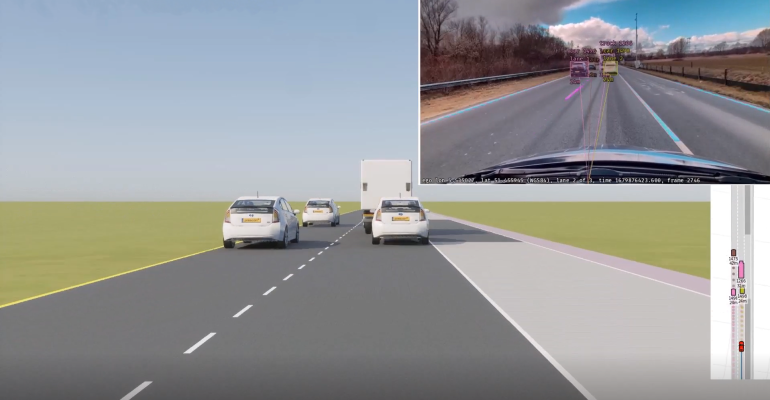As the automotive industry moves into the future, companies are faced with the challenge of building vehicles that offer greater convenience, safety and connectivity. The advent of software-defined and autonomous vehicles is only expected to magnify this trend, pushing the boundaries of vehicle complexity even further.
AVs in particular will require state-of-the-art components from multiple domains including software, semiconductor chips, sensors and electrical wiring – culminating in the most sophisticated vehicles ever produced.
The complexity of AVs as a system of systems will certainly be immense. Yet, the verification and validation of AV safety, reliability and performance in all traffic scenarios may prove an even more daunting task. Projections indicate AV platforms will need to complete the equivalent of billions of miles of testing to ensure their safety and reliability.
Thus, a critical challenge for AV manufacturers will be the development of verification and validation methods that can quickly evaluate the performance of these sophisticated vehicles in all manner of traffic and weather scenarios.
Growing Complexity Demands Merging of Real and Virtual
Mounting complexity throughout the vehicle development process compounds when it comes to verification and validation of an AV. A considerable volume of testing is necessary to investigate non-routine traffic situations that are difficult to predict when developing a self-driving system.
With a combined approach of real-world testing and simulation, AV engineering teams can identify on-road edge cases and assess vehicle behavior in all driving scenarios more quickly and cost-effectively.
Realizing such a combined real and virtual approach demands an integrated AV development platform that can test and retest the operation of the vehicle in realistic virtual scenarios throughout the design lifecycle. An integrated AV design and simulation platform enables test results and simulation data to be reincorporated into the vehicle design, creating a closed-loop system that improves the design, operation and physical characteristics of the system with high-fidelity data.
Such a platform is enabled by an extensive digitalization approach that supports the creation of a comprehensive digital twin of the AV, covering the design, verification and validation, in-field monitoring and optimization of the vehicle hardware, software, production and lifecycle.
Digitalization Supports a Combined Simulation Approach
The development of advanced driver assistance systems and autonomous vehicles is a data-driven engineering process. Large amounts of data are generated, analyzed and incorporated back into the design at each step in the lifecycle through the comprehensive digital twin. Translating the raw data gathered into engineering insights that drive improvements and optimizations is where competitive advantages can be won and lost.
It all starts with real-world data collection. Typically, the amount of data collected from a physical test is immense. Digitalized data collection solutions include software that can perform an initial analysis of the data, distinguishing data that is pertinent to the testing objective at hand and allowing teams to make well-informed decisions on data storage and processing priority.
The captured data becomes even more powerful when converted to the virtual domain. Real-world test data can enrich simulated vehicle environments and driving dynamics, leading to a much higher-fidelity digital twin. Scenarios captured during real-world testing also can be imported and recreated in a simulation solution. Once in the simulation environment, the engineering team can change all parameters of the scenario, such as weather conditions or vehicle speeds, allowing teams to interrogate all facets of system performance.
High-fidelity simulations of a comprehensive vehicle digital twin also present the best environment for the identification of so-called “unknown-unsafe” scenarios. Engineering teams can use the knowledge from known real-world situations in combination with mathematical methods to uncover alternative critical scenarios. Doing so in the virtual environment allows teams to discover and analyze these scenarios much more efficiently, reducing the number of unknown-unsafe scenarios and thus the risk incurred when deploying AV systems.
Build for the Future of Mobility With Digitalization
The successful implementation of automated driving systems rests in large part on our ability to solve the immense challenge of AV verification and validation. AVs will need to operate safely and reliably in all weather and traffic conditions, and in urban, suburban and rural settings. AV manufacturers and transportation companies will need to embrace the comprehensive digital twin to build a mixed-reality, digitalized approach to the development, verification and validation of their systems.
 As the future of automated transportation comes closer to reality, automotive and transportation companies face a transformation in both the products they create and in the methods with which they conduct business. While great opportunity exists in the future, the road there faces several impediments. Companies that commit to digitalization will overcome these obstacles and establish a strong foundation for the future of connected, automated and increasingly software-defined vehicles.
As the future of automated transportation comes closer to reality, automotive and transportation companies face a transformation in both the products they create and in the methods with which they conduct business. While great opportunity exists in the future, the road there faces several impediments. Companies that commit to digitalization will overcome these obstacles and establish a strong foundation for the future of connected, automated and increasingly software-defined vehicles.
Nand Kochhar (pictured, above left) is the vice president of automotive and transportation for Siemens Digital Industries Software. He joined Siemens in 2020 after nearly 30 years with Ford, where he most recently served as global safety systems chief engineer.





